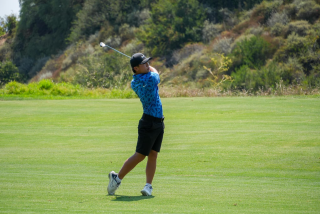Swing Club Like a Natural
- Share via
So you want to be a better golfer, huh?
Well, Joe Buttitta thinks he’s found a way to help you out.
Forget all those costly titanium clubs and don’t waste your time with those gizmos and gadgets from late-night infomercials.
Change your swing.
Buttitta, a PGA Professional at Westlake Village Golf Course, has been teaching an innovative, yet controversial, swing called Natural Golf.
The technique is rather simple. You grip the club with the palm of your dominant hand (right hand for right-handers) instead of the fingers, and take a wider than normal stance in order to inhibit hip turn.
Buttitta and Natural Golf proponents claim that this makes it easier for golfers to get the clubhead square at impact, leading to more accurate shots.
“The one single thing that drives players crazy is the timing involved to get the clubface square at impact,” Buttitta said. “It takes world-class timing and only 1% of golfers have that. With Natural Golf, it’s already on plane.”
It seems to work.
Jim Fisher of Chatsworth says he is hitting the ball better than he has in nearly 35 years of playing golf.
“My problem was I used to slice everything,” Fisher said. “But I’ve had three lessons with Natural Golf and hit about 50 buckets of balls and I haven’t sliced one. I hooked a couple, but no slices.”
As the name implies, the swing is supposed to feel more natural, but for experienced golfers it is anything but.
“I know of it, but I don’t teach it,” said Markel Taylor, head professional at El Caballero Country Club. “It’s harder to learn and more unnatural.”
The swing is definitely awkward at first. It’s a stiffer, more controlled swing, the opposite of the loosey goosey style most instructors preach.
“I’m not saying the conventional swing is bad,” Buttitta said. “It’s very good if you can hit it.”
The Natural Golf swing was unwittingly invented by Moe Norman, a member of the Canadian PGA Hall of Fame, who is touted by Lee Trevino and Ken Venturi as one of the greatest, straightest ball-strikers ever.
Only about six or seven professionals in Southern California teach Natural Golf, mostly because of skepticism.
Detractors say the restricted nature of the swing inhibits swing speed and creates a loss of distance.
“The control you gain is not worth the distance you lose,” Taylor said.
But Buttitta says he’s about 1 1/2 clubs longer than he was before using Natural Golf.
“This is not for everybody,” Buttitta said. “Fred Couples doesn’t need this, but we’re not teaching Fred Couples, we’re teaching Fred Flintstone--30-40 handicappers looking for something to help.”
Buttitta was skeptical at first, but he discovered some students just weren’t taking to the conventional swing and the teacher in him wouldn’t let them go away without learning.
“I kept seeing people walking off the tee disappointed and all I could say was, ‘You need more practice,’ ” Buttitta said. “When I first started teaching it everyone thought I was crazy, but I embrace it because it’s helped my students.”
Buttitta also teaches the conventional swing, and gives students the option of Natural Golf if the conventional swing doesn’t work.
“I want them to make the choice,” he said. “That way they can’t say I screwed them up.”
He also can’t say he forced them to invest in the method.
In order to execute the swing properly, a larger grip and a set of clubs adjusted two degrees upright are required.
Natural Golf sells already modified clubs at $1,500 for a set of three woods and eight irons, all graphite shafted.
Most clubs, however, can be modified for Natural Golf and a significantly lower price.
*
Jason Semelsberger of Newhall, Oliver Reinfurth of Northridge and Craig Steinberg of Van Nuys will play in the U.S. Amateur championship Aug. 24-30 at Oak Hill Country Club in Rochester, N.Y.
Back on the home front, many others will be trying to qualify for the men’s and women’s U.S. Mid-Amateur, the men’s U.S. Senior Amateur, the SCGA Mid-Amateur and the SCGA Senior Amateur.
What are these tournaments?
Here’s a quick reference guide:
U.S. Amateur--Open to male amateurs who have a USGA Handicap Index of 2.4 or lower. Qualifying through sectional tournaments.
U.S. Senior Amateur (Sept. 12-17)--Open to male amateurs who are 55 or older (on Sept. 12) with an index of 7.4 or less. Qualifying through sectional tournaments.
U.S. Women’s Senior Amateur (Sept. 14-19)--Open to female amateurs who are 50 or older (on Sept. 14) with an index of 12.4 or less. No qualifying required, the field is filled by the 132 applicants with the lowest indexes.
SCGA Mid-Amateur (Sept. 28-29)--Open to SCGA members who are 25 or older (on Sept. 28) and have an index of 5.4 or lower. Qualifying through local tournaments.
U.S. Women’s Mid-Amateur (Oct. 3-8)--Open to female amateurs who are 25 or older (on Oct. 3) with an index of 9.4 or lower. Qualifying through sectional tournaments.
U.S. Mid-Amateur (Oct. 3-8)--Open to male amateurs who are 25 or older (on Oct. 3) and have an index of 3.4 or lower. Qualifying through sectional tournaments.
SCGA Senior Amateur (Sept. 28-29)--Open to SCGA members who are 55 or older (on Sept. 28) and have an index of 8.4 or lower. Qualifying through local tournaments.
More to Read
Go beyond the scoreboard
Get the latest on L.A.'s teams in the daily Sports Report newsletter.
You may occasionally receive promotional content from the Los Angeles Times.










